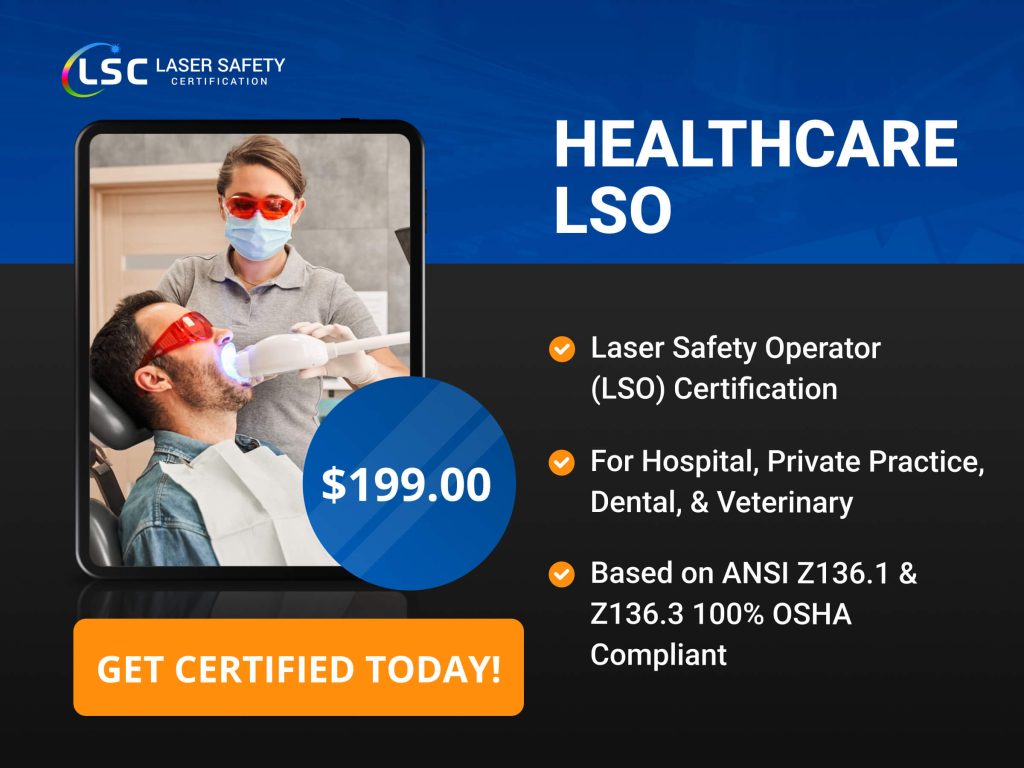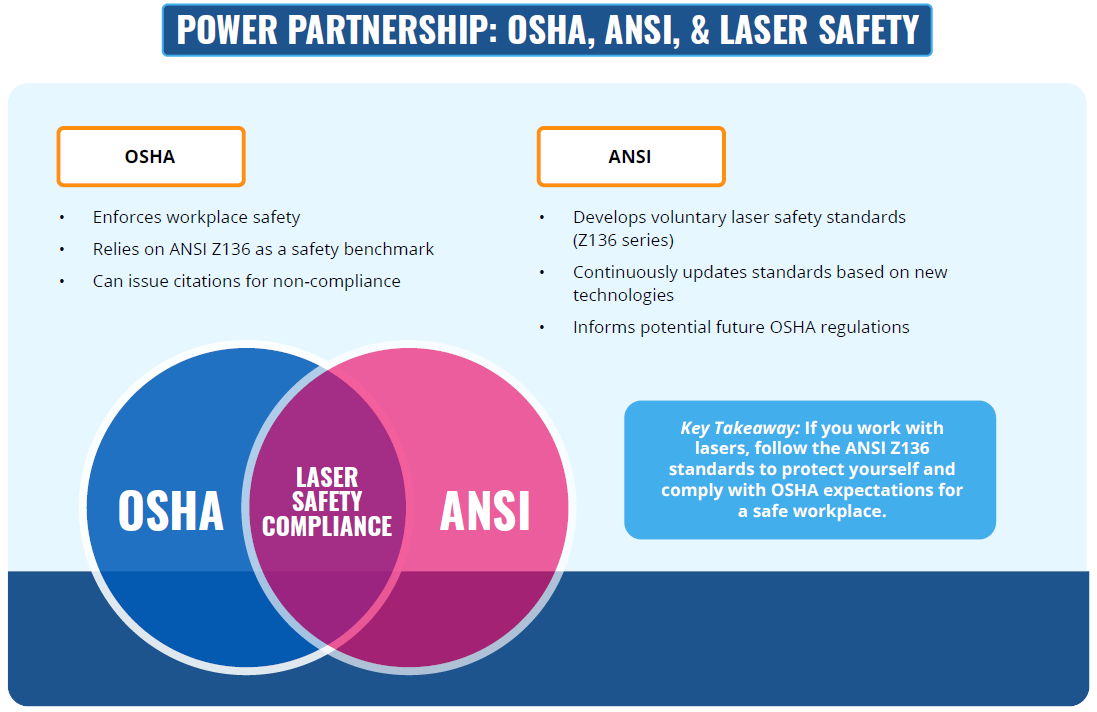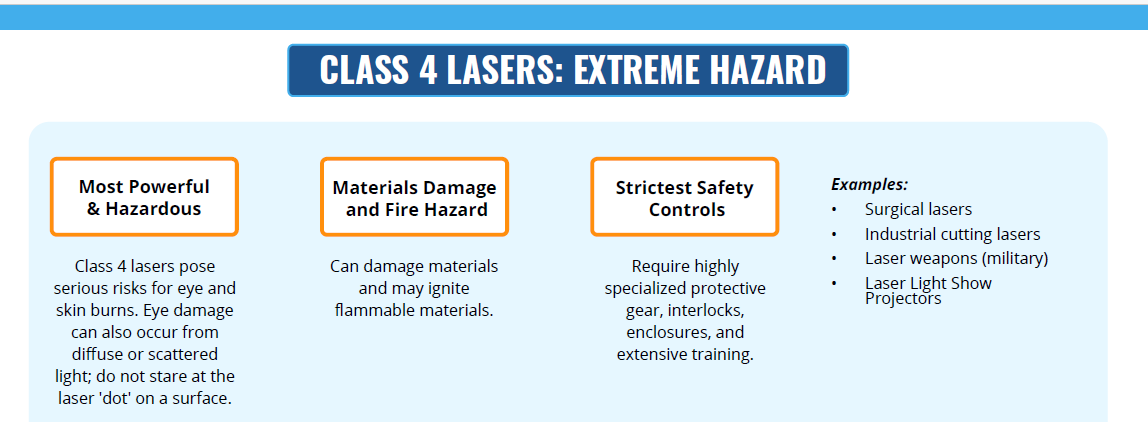Healthcare Laser Safety Officer Certification
What are the requirements to become a Healthcare LSO?
What do you need for a Healthcare LSO Certification?
To become a certified Laser Safety Officer (LSO) in a healthcare setting, several key steps and requirements must be met. These steps typically involve specific training, knowledge, and experience, which can vary depending on the certifying body and the specific needs of the healthcare facility. Here’s a comprehensive overview based on industry standards and best practices:
Training Requirements
Healthcare LSO Certification - $199
With our curriculum, you will become the in-house expert in the following:
- How Lasers Work
- Scientific Terms
- Hazard Evaluation
- Control Measures
- Medical Examinations
- Non-Beam Hazards
- Eye & Skin Exposure
- Hazard Classification
- Environmental Controls
- Protective Equipment
- Warning Signs
- Laser Generated Airborne Contaminants
- Secondary Radiation
- Fire Hazards
Does OSHA require a Laser Safety Officer in healthcare facilities?
Yes, OSHA does require a Laser Safety Officer (LSO) in healthcare facilities that use lasers, particularly for higher-class lasers which pose significant hazards. The role of the LSO in healthcare settings is crucial for ensuring the safe use of lasers and compliance with safety standards and regulations.
OSHA and ANSI Requirements
OSHA Standards:
- OSHA’s regulations emphasize the need for a comprehensive laser safety program in workplaces that use lasers, including healthcare facilities. This program must be overseen by a designated individual, typically the LSO, to ensure compliance with safety standards.
- The OSHA Technical Manual (OTM) specifically addresses the need for an LSO in environments where lasers are used, including healthcare, to implement safety measures and training programs.
ANSI Z136.3 – Safe Use of Lasers in Health Care:
- The ANSI Z136.3 standard specifically addresses laser safety in healthcare settings and mandates the designation of an LSO for facilities using Class 3B and Class 4 lasers. These lasers pose higher risks and require stringent control measures and oversight.
- The LSO is responsible for establishing and maintaining the laser safety program, conducting hazard evaluations, implementing control measures, and ensuring that all personnel are adequately trained.
Certification Process
Key Competencies and Skills
If you are in a healthcare facility with a Class 4 Medical Laser Device, who needs training?
In a healthcare facility that utilizes Class 4 medical laser devices, it is crucial that a comprehensive laser safety training program is implemented. Class 4 lasers are the most hazardous and require stringent safety measures. The following individuals need to receive safety training:
Laser Safety Officer (LSO)
The LSO must be present during the operation of Class 4 Medical Laser Device
LSO Role During Class 4 Laser Operation:
- The LSO is responsible for overseeing that laser safety is being properly administered during Class 4 Laser operation.
- The LSO is also responsible for conducting hazard evaluations, and ensuring compliance with safety regulations.
LSO Class 4 Laser Training Requirements:
- All Healthcare Laser Technicians must be trained in safe use of Class 4 Lasers according to ANSI Z136.3
- All patients underdoing procedures must have proper Personal Protective Equipment, but do not require training.
Healthcare Personnel (HCP) Operating the Laser
All HCP must be properly trained in safe use of Class 4 Lasers
HCP Role During Class 4 Laser Operation:
- The HCP must ensure safe use of the Class 4 laser device during its operation.
- The HCP is responsible for ensuring the safety of the patient undergoing the procedure.
HCP Class 4 Training Requirements:
- Basic laser physics and principles of operation.
- Specific operational procedures for the Class 4 laser device.
- Potential hazards associated with the use of the laser.
- Implementation of control measures, including the use of personal protective equipment (PPE).
- Emergency procedures and response protocols.
Maintenance and Technical Staff
Anyone working on the Class 4 medical laser device must be trained by the manufacturer
Maintenance Role During Class 4 Laser Operation:
- Individuals responsible for the maintenance, calibration, and technical support of the laser equipment.
- These personnel must be trained by the manufacturer in safe maintenance of the laser device
Maintenance Class 4 Training Requirements:
- Detailed understanding of the laser system’s technical specifications.
- Safe maintenance practices and procedures.
- Hazard evaluation during servicing and maintenance activities.
- Use of appropriate PPE and safety controls during maintenance.
Administrative and Support Staff
Anyone who has contact with the laser device should receive training
Support Role During Class 4 Laser Operation:
- These people may be responsible for transporting or storing the medical laser device
- Special care must be taken with fiber lasers to avoid fiber breakage
- Electrical hazards can occur during power-up or shut-down of the device
Administrative Class 4 Training Requirements:
- Basic understanding of laser safety principles.
- Awareness of the potential hazards in their working environment.
- Emergency procedures and how to respond in case of an incident.
- Importance of signage and controlled access to laser areas.
Patients and Visitors
Patient should receive an informal briefing of the hazards of the procedure, and be provided with sufficient PPE
Patient Role During Class 4 Laser Operation:
- Patients undergoing procedures involving lasers and any visitors in the vicinity of the laser operation should receive informal hazard awareness training.
- This includes people observing the procedure.
Patient Class 4 Training Requirements:
- Patients should be informed about the procedure, the laser’s role, and the safety measures in place to protect them.
- Visitors should be made aware of restricted areas and safety protocols to avoid accidental exposure.
Key Components of the Training Program
Summary
OSHA and ANSI standards mandate the appointment of a Laser Safety Officer in healthcare facilities that use higher-class lasers (Class 3B and Class 4). The LSO plays a vital role in ensuring the safe use of lasers by implementing safety programs, conducting training, performing hazard evaluations, and maintaining compliance with regulatory requirements. This role is essential for protecting healthcare personnel and patients from laser hazards.
To become a certified Healthcare Laser Safety Officer (LSO), you need to complete a comprehensive training program, pass a certification exam, and acquire practical experience in laser safety. Familiarity with ANSI Z136.3 standards and OSHA regulations is essential, along with skills in hazard evaluation, implementation of control measures, and effective training and communication. Continuing education and periodic recertification help maintain the necessary expertise to ensure ongoing compliance and safety in healthcare laser applications.
In a healthcare facility using Class 4 medical laser devices, safety training is mandatory for all personnel directly or indirectly involved with the laser operation. This includes the Laser Safety Officer, healthcare personnel operating the laser, maintenance and technical staff, and administrative and support staff. Patients and visitors should also be informed about safety measures. The training program should cover laser physics, regulatory compliance, hazard control measures, emergency procedures, and practical demonstrations to ensure a comprehensive understanding of laser safety.



